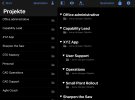Anyway, getting more experienced about GTD, made me realise that I like simple systems. A good sandbox of stuff is better for me that a collection strictly organised by folders and subfolders. Too much organisation kill efficiency and organisation.
This has been my experience as well. If I recall correctly, I think David Allen's advice about contexts and inboxes is something along the lines of having as many as you need, but as few as you can get by with. I think a similar idea can be applied to structure: apply as much as you need, but as little as you can get by with.
My particular issue has always been applying too much structure. Way, WAY too much. By trying to control too much (everything, really) I inevitably lost my grip on the few things I actually could control.
I've been reluctant to post such thoughts in this thread because I don't use Omnifocus. I don't want to offer an opinion about something I don't understand. But... you kind of opened the door for me to share this thought. Or at least that's what I'm telling myself.

When it comes to AOFs, regardless of the tool I use I just don't think of AOFs or any of the horizons above it to be a rigid hierarchy. I just feel that adds a burden with no commensurate payoff.
I feel AOFs and above are things to review at appropriate intervals to help me decide whether I'm addressing the right areas of my life or not. Sometimes certain of my AOFs don't need a project or action because they're on cruise control. Sometimes I have a project or action that doesn't map to my AOFs or a higher level. In my world, these things are OK.
Like I said, I wouldn't know how that would or would not work in Omnifocus. It's not a tool I can even try -- I use a PC rather than a Mac. So, y'know, out of respect for
@ivanjay205 I didn't want to sound off about something I have no experience with. I guess I would say, however, that if
@ivanjay205 feels the complexity of their system makes it difficult to determine if they're working on the right things, some simplification is definitely in order. Decoupling AOFs and above from projects and actions might help.
Things is also just simple and efficient. It is like Nirvana.
It's funny you mention Nirvana. I used to use it. I abandoned it in favor of Todoist. Then I kinda let my whole GTD system go to hell. Todoist is now filled with irrelevant nonsense, and Nirvana was empty because I abandoned it. So I returned to Nirvana because it is a blank slate that allows me to rebuild my system from the ground up.
I used to have a love/hate relationship with Nirvana. I was frustrated by the things it doesn't do. Recently, however, I realized that I've found a way to be annoyed with every single tool I've tried. Have you ever heard the saying, "The common denominator in all your bad relationships is you"? I feel that way about my relationship with list managers. LOL!
Right now, I'm really enjoying the simplicity of Nirvana. I don't have to think about it when I use it. It's simple and easy. Can it do everything I imagine a list manager could do? No. But then, neither can anything else. Nirvana does what I need.
This is not intended to be an advertisement for Nirvana. Todoist is also a good tool. I've heard good things about Things (no pun intended), but I'm not a Mac user so it's not a solution for me. I know there are many happy Omnifocus users, and there's even a GTD setup guide available for it which says to me someone at the David Allen Company has determined that, yeah, this is a good tool.
Anyway, guess I thought it would be OK to chime in to say you and I think along similar lines when it comes to tools. I like what I consider to be "simple and efficient."




